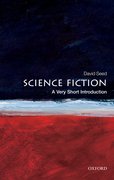
Science Fiction: A Very Short Introduction
By David Seed
In 1998, Thomas M. Disch boldly declared in The Dreams Our Stuff Is Made Of: How Science Fiction Conquered the World that science fiction had become the main kind of fiction which was commenting on contemporary social reality. As a professional writer, we could object that Disch had a vested interest in making this assertion, but virtually every day news items confirm his argument that science fiction connects with an amazingly broad range of public issues.
Take the ongoing debate over different forms of surveillance. There is a long libertarian tradition in science fiction of describing resistance to any kind of private or governmental surveillance in the works of Philip K. Dick and many others. The novelist David Brin joined the debate with his polemic on freedom and privacy in The Transparent Society, but that was published before the attacks of 9/11 in 2001 changed the political climate. Nowadays the USA has even to a certain extent institutionalized science fiction through the SIGMA think tank which advises government agencies including the Bureau of Homeland Security on likely futures.
 And what about space? Many members of NASA grew up on a diet of science fiction which has no doubt fed into their projects and designs, but, apart from that, it has become obligatory to signal any new development by drawing a comparison with science fiction. When NASA offered a prize for the best design for an autonomous robot which could be used to explore remote planets, it was immediately compared to the Imperial Probe Droid from Star Wars.
And what about space? Many members of NASA grew up on a diet of science fiction which has no doubt fed into their projects and designs, but, apart from that, it has become obligatory to signal any new development by drawing a comparison with science fiction. When NASA offered a prize for the best design for an autonomous robot which could be used to explore remote planets, it was immediately compared to the Imperial Probe Droid from Star Wars.
Back in the science fiction of the 1980s and 1990s, virtual reality was something characters accessed through elaborate helmets and suits with complex sensors, which, writers like Pat Cadigan showed, could function like a powerful drug and alienate the wearer from any kind of external reality. Now the development of computerized eyeglasses is trumpeted as ‘making science fiction real’ through this new technology.
One difference from the older VR suits is that they tended to robotize the appearance of the wearer, but the new glasses look conventional visually while they speed up the processing and transfer of information.
Another standard theme in science fiction has been the exploration of the nature of humanity and of our relation to constructs like hybrid combinations of machine and organism — the cyborg — or projected versions of humanity which have become known as ‘avatars’. While he was working on his film Avatar (2009), James Cameron explained his title term as follows: “In this film what that means is that the human technology in the future is capable of injecting a human’s intelligence into a remotely located body, a biological body.”
Cameron’s application follows a principle of transference and repeats the old science fiction dream of the human mind being projected beyond its bodily limits. Indeed, Cameron admitted that he was drawing on the whole tradition of science fiction for his film and attempting to apply ‘wrap-round’ technology to give the viewer maximum immersion in the spectacle. The more common use of ‘avatar’ denotes a computerized human simulation, introduced as early as 1975 in John Brunner’s The Shockwave Rider and then further dramatized in Neal Stephenson’s Snow Crash (1992). Brunner shows his character in flight from a threatening government programme; Stephenson evokes a more complex situation where his protagonist negotiates his way between different information systems. In Snow Crash avatars confuse their observers by blurring the boundaries between the physical body and its representations, whereas since the 1990s they have become staples of modelling and self-modification. The website Technovelgy includes these cases among many others embodying links between SF and technology.
As the UK novelist Paul Kincaid has said, science fiction is uniquely concerned with novelty, which very quickly produces ennui and so in that sense it is a ‘genre at the end of time.’
This is another way of saying that science fiction is constantly re-inventing itself. A concern with novelty involves a hyper-awareness of time. As Kincaid argues, maybe it’s a paradoxical sign of the continuing energy of science fiction that we hear so often of its demise.
David Seed is Professor in the School of English at the University of Liverpool and the author of Science Fiction: A Very Short Introduction.
Subscribe to the OUPblog via email or RSS.
Subscribe to only VSI articles on the OUPblog via email or RSS.
View more about this book on the ![]()
![]()


[…] The continuing life of science fiction […]
[…] launch of Telstar appealed to Meek’s obsession with space travel and science fiction, nurtured in part by his National Service deployment at a radar station. He imagined the roar of […]